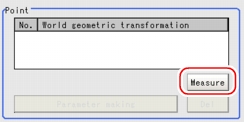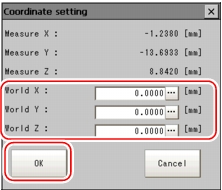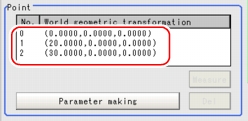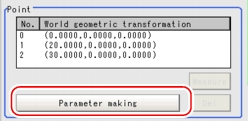[3D Setting: World Coordinates (3D Camera Image)]
Create a conversion parameter by photographing calibration target and performing sampling measurement at several points. Use this parameter to convert the [Measurement] in the image photographed with the camera to actual dimensions in the world coordinate (spatial coordinate).
The method of the measurement using a white circle outline at the center of the calibration target is described below.
- Tap [3D setting] in the "Item tab" area (top) and tap [World coordinates] in the "Item tab" area (bottom).
- In the "Sampling condition" area, tap [...] for "Repetition frequency" and enter a value.For how to input value, see
 User's Manual, "Inputting a Value"
User's Manual, "Inputting a Value" - Photograph the calibration target with the camera.
- In the "Point" area, tap [Measure].The circle at the center of calibration target is measured with each camera. Coordinate calculation is performed based on the measurement result.
- Change the world coordinate (spatial coordinate) as necessary and tap [OK].
- Move the calibration target and repeat the Steps
 4 and
4 and  5 twice.
5 twice. - After three points (No. 0 to 2) are entered in "Point", tap [Parameter making].





